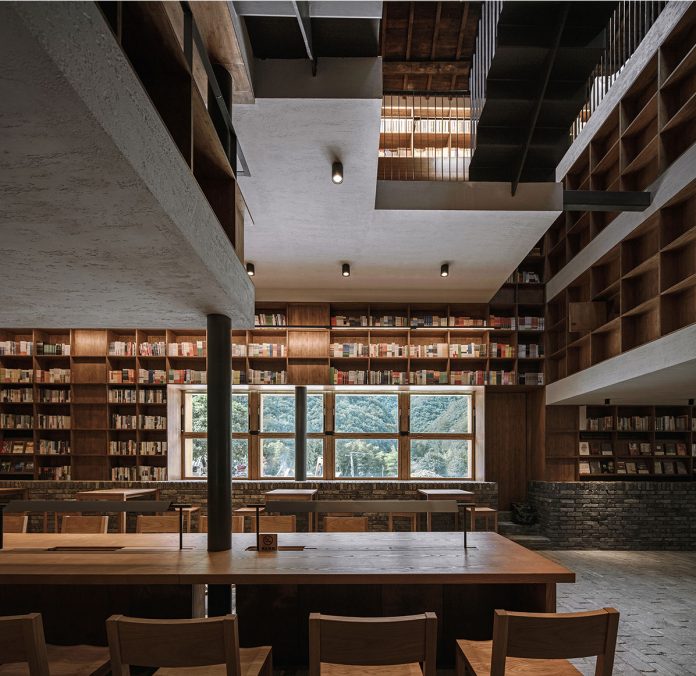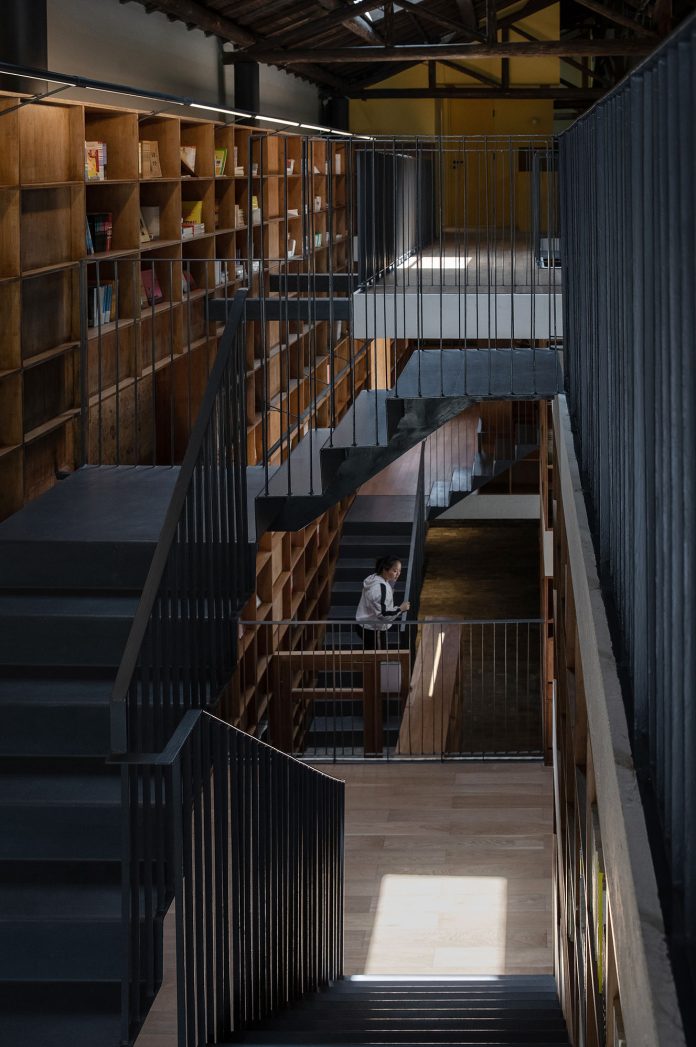Architect’s firm: Atelier tao+c
Location: Tonglu, Zhejiang Province, China
Completion Date: June 2019
GFA: 232 sqm
Design team: Tao Liu, Chunyan Cai, Guoxiong Liu, Lihui Han
Furniture and lighting design: TIWUWORKS
Product designer: Yun Zhao, Xiaowen Chen
Structure and MEP consultant: Shanghai Fengyuzhu Culture Technology Co., Ltd.
Photographer: Su Sheng Liang (except noted)
Key materials: laminated bamboo planks, grey bricks, textured paint, corrugated polycarbonate panels
Contractor: Du Construction
Site managers: Huarong Liao, Daguo Jing
Client: Fang Yu Kong Cultural & Creative Resort Complex
Text description provided by the architects
Qinglongwu in Zhejiang is a city in China about 731 mi (or 1,177 km) south of Beijing, the country’s capital city. It is an ancient city surrounded by the forests of Tonglu, a great place for creative minds. An old house of wood structure and mud walls is entrenched along a road in the village, facing the green mountains in the south and east side and a lower courtyard in the north. Commissioned by the client, Atelier tao+c redesigned and regenerated this 232sqm old building by inserting a capsule hotel that can host up to 20 people, a bookstore and a library into the 7.2-meter high two-stories space.
The Capsule Hotel and Bookstore’ s challenge
Preserving the privacy of the accommodation area, while keeping the openness of the public areas was the biggest challenge faced by the architects.
After removing the original floors and partition walls, the architect opened the ground floor for library and open spaces, placed two independent “floating” structure above the open spaces, which will be used separately for male and female guests. The company found a solution to allow people to sit or to lie low: it divided the floating mass by 1.35 meters, a sufficient hight for this trick, then split and staggered the floor slabs to create an unconventional three-floor space with interesting perspectives. The hotel visitors can find a place to stand and walkthrough, as the staggering floor slabs formed a few “double-height” spaces in the accommodation areas.
Visitors can meander, ascend, stop, read, snoop and rest in the capsules
Multiple layers of visual connections, sounds and eye contacts are intertwined with the staggering platforms and it creates a sense of floating. The architects used metal staircases to connect the split and stacked floors. The stairs, 9 for each section, recreate the paths in the mountains, forming a zigzagging route with quick turns. The purpose was to allow people to meander, ascend, stop, read, snoop and rest in the capsules. The visitors get a great feeling of lost and found, they are allowed to experience the fun in exploring this indoor garden.
”The buildings” are equipped with ten capsule rooms and one bathroom for males and females as well. The privacy of the accommodation area is ensured by the modular capsule rooms of uniformed size that are hidden and enclosed by bookshelves. People can smell the bamboo freshness inside, as the planks of the bookshelf are made from local bamboo. The window of each capsule room was designed to correspond exactly to a compartment of the bookshelf, coming into different layers of eye contact and voyeuristic views. What you smell and see in this space are intertwined together to produce an intriguing journey of senses.
The definition between inside and outside becomes relative in this Capsule Hotel and Bookstore
The boundaries of various spaces are blurred by the idea of ”building inside building” and is also helps to form a balance between the privacy of the “floating” accommodation area and the openness of the public space on the ground floor. However, when you are looking at the front of the two “buildings” from the entrance hall, you will find a clear cross-section relationship between the staggering floor slabs, while the capsules on the other sides of the masses are aligned with the infinitely repeated modular compartments of the bookshelf. It is where the definitions of inside and outside become relative and the experiences become interchangeable.
The architects made restrained openings on the exterior wall to maintain the original simplicity of the building while keeping the vertical programming of the capsule rooms. The wooden frames of the new glass windows express an earthy vibe, being naturally integrated with the rammed earth wall and the original old windows in the wall; the grey bricks of the outdoor ground are inconspicuously extended into the interior.
The architect cut the whole gable wall on this side and embedded a transparent structure of wooden frames and corrugated polycarbonate panels, introducing the green of the mountains and forests into the interior in order to explore the amazing natural landscape at the east end of the building.
The openings in the ceiling also bring rich natural lights into the interior spaces. At twilight, the whole building is illuminated by the light from the indoor, and the building itself becomes a lighthouse, offering a slice of warmth to the calmness of the night. The feeling of togetherness is expressed by the fragrance of bamboos and books in a building that has the power to gather the visitors in one place. It becomes part of their feelings and memories, and will further inspire a new future of life to the village.
In conclusion
The Capsule Hotel and Bookstore designed by Atelier TAO+C gives visitors a sense a togetherness while they walk through the stairs of their memory in an intriguing journey of senses.







